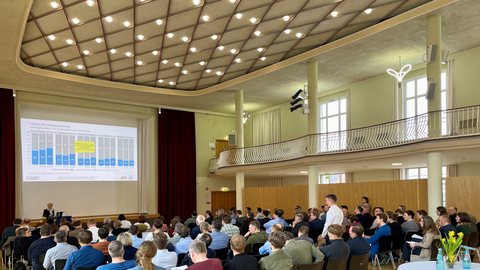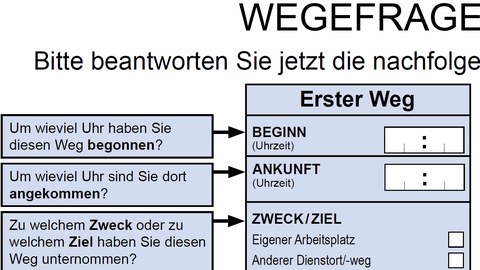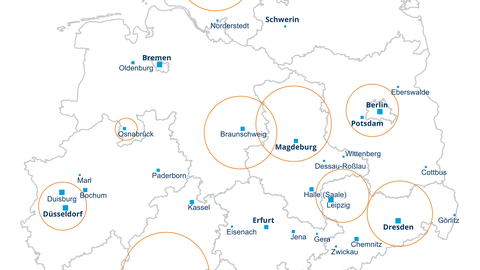Ergebnisse
Die Feldzeit des 12. Durchganges der Zeitreihenuntersuchung "Mobilität in Städten – SrV" konnte Anfang 2024 erfolgreich abgeschlossen werden. Die Erhebung lief seit Januar 2023 zeitgleich in etwa 500 deutschen Städten und Gemeinden.
Die stadt- und untersuchungsraumspezifischen Ergebnisse liegen der Auftraggeberschaft seit Dezember 2024 vor.
Der SrV-Städtevergleich 2023, stadtübergreifende Auswertungen sowie der Methodenbericht des aktuellen Erhebungsdurchgangs können auf dieser Seite heruntergeladen werden. Klicken Sie einfach auf "mehr erfahren" oder scrollen Sie nach unten.
Ergebnisse des SrV 2023
Stadtübergreifende Trends und zentrale Erkenntnisse des Erhebungsdurchgangs 2023 sind in einer Präsentation zusammengestellt.
Der SrV-Städtevergleich stellt zentrale Basiskennwerte zum Verkehrsverhalten der Wohnbevölkerung für die sich daran beteiligenden Untersuchungsräume gegenüber. Damit wird einerseits die Variationsbreite der erhobenen Kennwerte für die SrV-Untersuchungsräume sichtbar gemacht. Andererseits ermöglicht das Dokument direkte Vergleiche zwischen den teilnehmenden Städten und Landkreisen im Sinne eines Benchmarkings. Für die sachgerechte Einordnung der Erkenntnisse aus diesen Vergleichen sollten die örtlichen Randbedingungen der Vergleichsstädte Berücksichtigung finden.
SrV-Städtevergleich 2023 (aktualisierte Version vom 02.06.2025)
Die Tabellierung stadtübergreifender Ergebnisse dient dem Ziel, Merkmalskombinationen stärker differenziert als in den stadt- und untersuchungsraumbezogenen Standardtabellen auswerten zu können. Dadurch sind Aussagen möglich, die für eine Einzelstadt in der Regel keine statistisch belastbaren Ergebnisse erwarten lassen. Städte, die nicht am SrV teilgenommen haben, erhalten durch Mobilitätskennziffern für Stadtgruppen die Möglichkeit, Orientierungswerte für typische Ausprägungen des Verkehrsverhaltens in ihrer eigenen Kommune zu gewinnen.
Die erste Systematik folgt vorrangig der Berücksichtigung modellierungstechnischer Aspekte als Querschnittanalyse des aktuellen Erhebungsdurchganges. Da die Zusammensetzung der Stadtgruppen in Abhängigkeit von den beteiligten Kommunen variiert, sind sie für Zeitreihenbetrachtungen nur bedingt geeignet. Auf Basis der Merkmale Zentralität, Einwohnerzahl und Topografie wurden sieben Stadtgruppen gebildet:
- Unter-/Grund-/Kleinzentren/ländliche Gemeinden, Topografie: flach
Mobilitätssteckbrief Tabellenbericht - Unter-/Grund-/Kleinzentren/ländliche Gemeinden, Topografie: hügelig
Mobilitätssteckbrief Tabellenbericht - Mittelzentren, Topografie: flach
Mobilitätssteckbrief Tabellenbericht - Mittelzentren, Topografie: hügelig
Mobilitätssteckbrief Tabellenbericht - Oberzentren bis unter 500.000 EW, Topografie: flach
Mobilitätssteckbrief Tabellenbericht - Oberzentren bis unter 500.000 EW, Topografie: hügelig
Mobilitätssteckbrief Tabellenbericht - Oberzentren 500.000 und mehr EW (ohne Berlin), Topografie: flach
Mobilitätssteckbrief Tabellenbericht
Die zweite Systematik dient vor allem der stadtübergreifenden Ergebnisdarstellung und eignet sich für Zeitreihenbetrachtungen. Wie bereits in den SrV-Durchgängen 2013 und 2018 existieren die folgenden drei Stadtgruppen:
- SrV-Städtepegel
Mobilitätssteckbrief Tabellenbericht - SrV-Wiederholerstädte West
Mobilitätssteckbrief Tabellenbericht - Große SrV-Vergleichsstädte
Mobilitätssteckbrief Tabellenbericht
Weitere Erläuterungen zu den Stadtgruppenauswertungen finden sich in den Tabellenberichten.
Der Methodenbericht zum SrV 2023 stellt das Erhebungskonzept umfassend dar. Neben der Beschreibung des methodischen Vorgehens bei der Datenerhebung sind Informationen zum Stichprobenkonzept, zur Datenaufbereitung und zur Gewichtung enthalten. Im Anhang des Berichts ist der Fragebogen dokumentiert.




